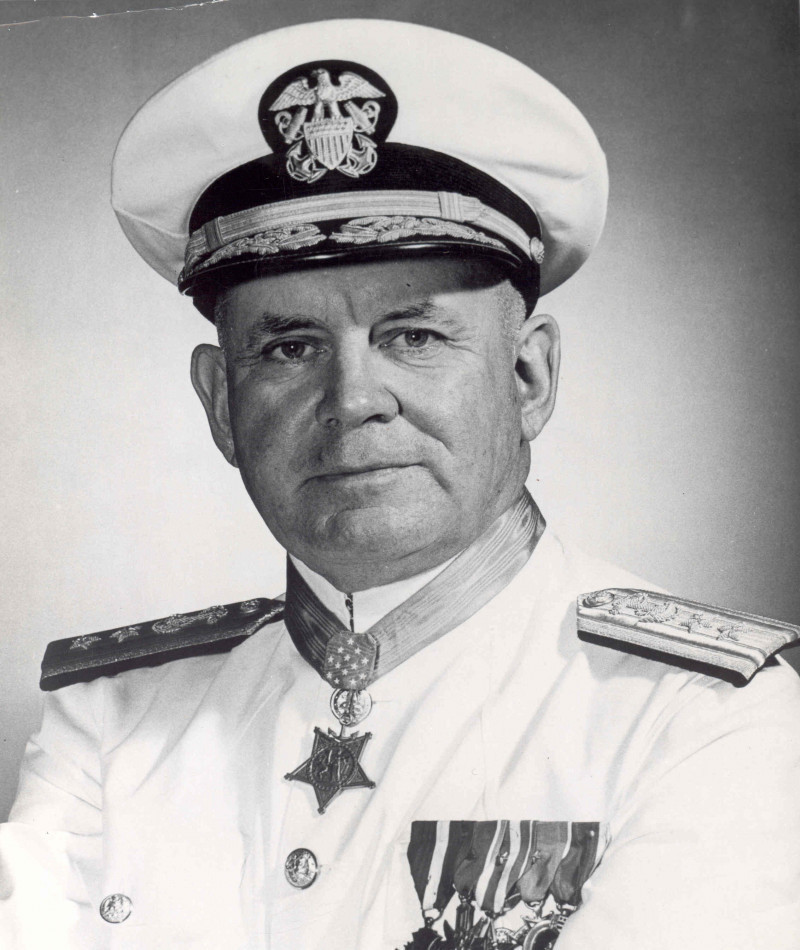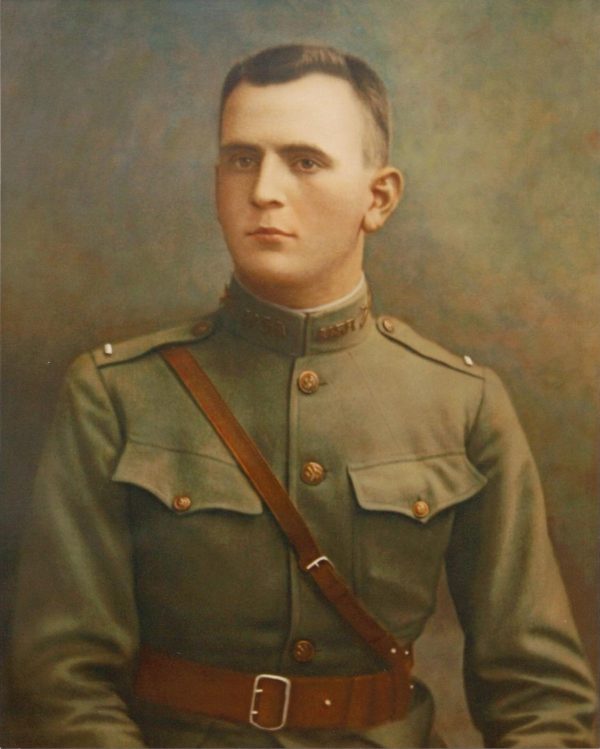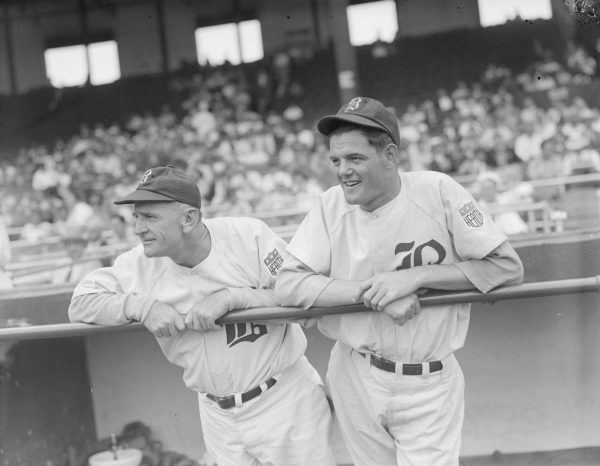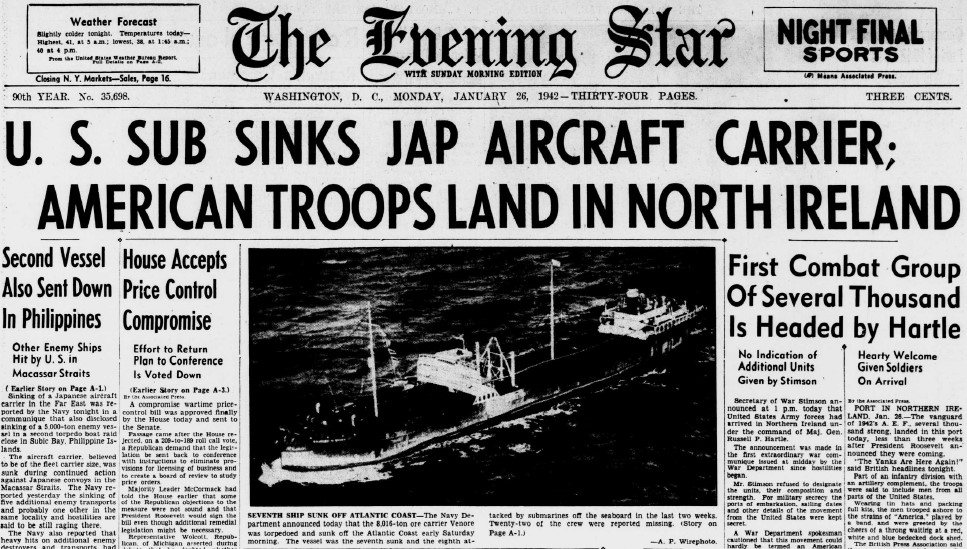World War II Chronicle: January 26, 1942
Click here for TODAY’S NEWSPAPER
The White House reports that today, the first U.S. ground troops have arrived in Europe. 4,508 soldiers of the 34th Infantry Division1The 34th Division is a federalized National Guard unit consisting of soldiers from Iowa, Nebraska, Minnesota, and the Dakotas departed New York City on 15 January, sailing through U-boat infested waters before safely reaching Belfast, Northern Ireland. As his yankees spend the next several months training, division commander Maj. Gen. Russel P. Hartle is tasked with creating an American version of the British Commandos — the outfit that would become the Army Rangers. Hartle picks his aide-de-camp, Capt. William O. Darby, to form the outfit. 34th Division volunteers account for most of the Army’s original 500 Rangers…
In the Philippines, the torpedo boats have struck again (see the front page). Over the course of the war, the three Naval officers mentioned — Ensign George E. Cox Lt. John D. Bulkeley, and Lt. (j.g.) Edward G. DeLong — and earn five Silver Stars, three Distinguished Service Crosses, three Navy Crosses, and one Medal of Honor for valor.

Bulkeley still has several more weeks of death-defying raids to come, but after hauling a VIP out of the Philippines (who celebrates his birthday today) he is ordered to return to the United States. There, Bulkeley crosses paths with a young Naval Reserve ensign named John F. Kennedy assigned to the Office of Naval Intelligence’s Charleston, S.C. field office. He talks Kennedy into joining the torpedo boat service.
Years later, President Kennedy (featured image) promotes Bulkeley to vice admiral and picks him to command the naval base at Guantanamo Bay, Cuba during the Cold War.
Sports section begins on page 16, and mentions that Iowa is raising funds to buy ambulances for the Red Cross. They will be named after athletes like Fred Becker. Despite playing just one season of college football, Becker becomes the first All-American in Iowa Hawkeye history. He trades his cleats for an Army officer’s commission, and heads for France. Due to officer shortages in the Marine Corps he is assigned to 2nd Battalion, 5th Marines and is wounded at Belleau Wood. He earned a Distinguished Service Cross during the Battle of Soissons for assaulting enemy machinegun positions, and was killed shortly after by artillery fire…

Page 16 also features an interesting column by Grantland Rice on great left-handers in sports, such as newly enshrined Hall-of-Famer Rogers Hornsby, who was particularly talented in instructing players in hitting. He finishes with a quote from Casey Stengel who is entering his fifth season with the Boston Bees/Braves. Boston’s National Leaugue franchise has gone by many names over the years, but reverted to the Braves after the 1941 season began.

So far, the “Old Perfessor” has accrued a record of 475-593 (and eight ties) and his clubs haven’t finished higher than fifth place. Hard to imagine the Yankees will win five straight World Series once he becomes skipper in 1949.
Speaking of Bees, a 20-year-old left-handed pitcher named Warren Spahn has moved up to the Hartford Bees, Boston’s Class-A minor league affiliate.2Minor League classification in the 1940s was different than today: Now we have AAA being the highest, followed by AA, etc. Back then, Class-A was one step below the Majors. B below that, then C, and D which was the lowest. Spahn impresses the big-league club enough during spring training to get called up to Boston in April.
“He’s only 20 years old and needs work,” Stengel said about Spahn. “But mark my word, if nothing happens to the kid, he can be a great one. Someday he’s going to be one of the best left-handers in the league.”
Evening star. (Washington, D.C.), 26 January 1942. Chronicling America: Historic American Newspapers. Lib. of Congress.
https://chroniclingamerica.loc.gov/lccn/sn83045462/1942-01-26/ed-1/
